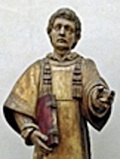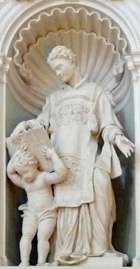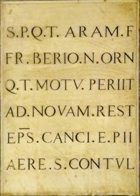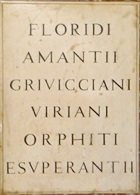

St Amantius (26th September)

St Amantius (16th century)
by Alberto di Giovanni Alberti
Museo del Duomo
An entry in the Roman Martyrology under 26th September records:
-
“At Città di Castello, St Amantius, a priest distinguished for the gift of miracles”.
St Amantius and the Dialogues
According to the Dialogues, Pope GregoryI heard from St Floridus of the life of “a certain Priest called Amantius, of marvellous simplicity” with whom he shared his home. Gregory I invited them both to Rome because he had heard about St Amantius’ gift for healing (as well as his ability to kill snakes by making the sign of the cross). While there, St Amantius calmed a mad man who had “fallen into a frenzy”.
SS Floridus and Amantius
St Amantius features in the earliest known legend of St Floridus, the Vita Floridi (BHL 3062), which was written in 1077 by Canon Arnolfo of Arezzo. This relates that, when SS Floridus and Amantius returned to Città di Castello from Perugia during the period in which Totila was laying waste to the area, they found it in ruins. St Floridus organised the rebuilding of the city and was consecrated as its bishop in ca. 580. As he approached death (traditionally in 599), he moved with St Amantius to Pieve dei Saddi (now in the Commune of Pietralunga, some 10 km from Città di Castello), and built a house on the burial site of St Crescentian. St Floridus died there on 13th November.

Relics of St Amantius



The relics of St Floridus are preserved under the Altare dei Corpi Santi the crypt, which is directly under the crossing of the church above. The inscriptions on the front of it (illustrated above) record that Bishop Peter (PETRVS) placed them here in the 11th century and that they were recognised on two subsequent occasions:
-
✴in 1540, by Bishop Alessandro Filodori (ALXA), following the rebuilding of the Duomo; and
-
✴in 1793, by Bishop Pietro Boscarini (PETR), four years after the earthquake that destroyed the original altar.


The inscriptions on the back of the altar list the saints whose relics were placed here by the canons of the Duomo: not only St Floridus and St Amantius, but also four of the so-called Martyrs of Saddi.


The reliquary is inside a stone sarcophagus under the altar. The inscription on the back of it reads:
PRAESULIS HIC FLORIDI REQUIESCUNT OSSA BEATI
CORPORA SANCTORUM NECNON SUNT HIC ALIORUM
CUM QUIBUS ET SANCTI REQUIESCIT CORPUS AMANTI
CUNCTOS HIC SALVENT AUXILLA DIGNA PETENTES
Here lie the blessed bones of Bishop Floridus
and the bodies of other saints
With them is the body of St Amantius
Here, all who ask shall find salvation
St Donninus (12th October)

St Donninus is represented with SS Floridus and Amantius on the silver altar frontal (12th century) that Pope Celestine II gave to the Duomo in 1144: the frontal is now in the Museo del Duomo.

Return to Saints of Città di Castello

